Acta medica Lituanica
 ISSN 1392-0138 ISSN 2029-4174 (online) |
2011 m. Nr. 3 Oncological outcomes of surgery in very high risk pT3b prostate cancer
Background. The aim of the study was to present the oncologic outcomes and to determine the prognostic factors of overall (OS) and cancer-specific survival (CSS) as well as disease-progression-free survival (DPFS) after surgery for pT3b prostate cancer.
Materials and methods. In 2002–2007, a pT3b stage after radical prostatectomy was detected in 56 patients. Patients were divided into groups according to the prostate-specific antigen (PSA) level (<10 vs. 10–20 vs. >20 ng/ml), lymph nodes status (N0 vs. Nx vs. N1) and the Gleason score (6–7 vs. 8–10). The Kaplan–Meier analysis was used to calculate OS, CSS and DPFS. The Cox regression was used to identify the predictive factors of survival. Results. Five-year OS, CSS and DPFS rates were 75.1%, 79.6% and 79.3%, respectively. The survival was significantly different when comparing the Gleason 6–7 and 8–10 groups. The 5-year OS, CSS and DPFS were 91.2% vs. 48.6%, 97.1% vs. 51.1% and 93.8 vs. 51.1%, respectively. There was no difference in survival among the groups with a different PSA level. The OS and CSS but not DPFS were significantly different when comparing the N0 and N1 groups. The 5-year OS and CSS was 84.4% vs. 37.5% and 87.3% vs. 47.6%, respectively. The specimen Gleason score was a significant predictor of OS and CSS. The risk of death increased up to 4-fold when a Gleason score 8–10 was present at the final pathology. Conclusions. Radical prostatectomy may offer acceptable CSS, DPFS and OS rates in pT3b PCa. However, outcomes in patients with N1 and specimen Gleason ≥8 were significantly worse, suggesting the need of multimodality treatment in such cases. Keywords: prostate cancer, locally advanced, surgery, outcome |
Issues:
2011 - Vol.18 No. 1, No. 2, No. 3, No. 4 2010 - Vol.17 No. 1-2, No. 3-4 2009 - Vol.16 No. 1-2, No. 3-4 2008 - Vol.15 No. 1, No. 2, No. 3, No. 4 2007 - Vol.14 No. 1, No. 2, No. 3, No. 4 2006 - Vol.13 No. 1, No. 2, No. 3, No. 4 2005 - Vol.12 No. 1, No. 2, No. 3, No. 4 2004 - Vol.11 No. 1, No. 2, No. 3, No. 4 2003 - Vol.10 No. 1, No. 2, No. 3, No. 4 2002 - Vol.9 No. 1, No. 2, No. 3, No. 4 2001 - Vol.8 No. 1, No. 2, No. 3, No. 4 |